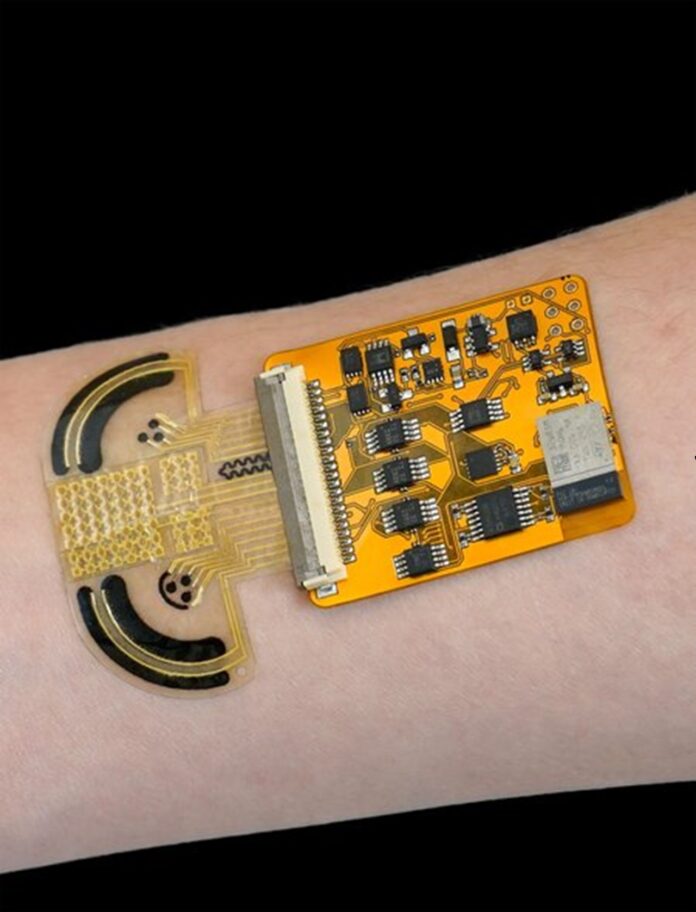As a medical engineering assistant professor, Caltech Institute of Technology‘s Wei Gao created a unique wearable called CARES (consolidated artificial intelligence-reinforced electronic skin). It’s like electronic skin that sticks to your wrist. This brilliant sticker keeps an eye on nine different signs of stress without disrupting your regular daily routines. This means people can go about their day as usual while the device measures both normal stress levels and sudden stress reactions.
Stress is a tricky thing to understand. We use the word to talk about feeling stressed or stressful situations. Sometimes, we connect stress to physical issues like headaches or teeth grinding. “stress” covers many feelings, symptoms, behaviors, and experiences.
A doctor named Hans Selye was the first to call stress a medical condition. He noticed that many patients with different illnesses complained about similar things, like tiredness and lack of motivation. Selye thought they were all reacting to a common factor—being sick. So, he defined stress as the body’s “nonspecific response to any demand.”
Stress can feel like excitement or energy, but it can also bring negative feelings like shock or anxiety. No matter how we experience it emotionally, both short-term (acute) and long-term (chronic) stress can harm our physical and mental health, affecting how well we can do things.
Since stress is not specific and varies from person to person, there’s no one test to say how stressed someone is.
However, the body reacts in specific ways to stress, creating a bunch of signs that, when looked at together, can give an idea of how stressed a person might be. CARES, developed by Gao, keeps an eye on these signs to measure stress without relying only on what people say about their stress levels.
Gao Institute and a Ronald and JoAnne Willens Scholar explain, “When a person is under stress, hormones like epinephrine, norepinephrine, and cortisol are released into the bloodstream. Sweat becomes rich in metabolites like glucose, lactate, and uric acid and electrolytes like sodium, potassium, and ammonium. We have measured these substances before using microfluidic sampling on a wearable sweat sensor. What is new in CARES is that sweat sensors are integrated with sensors that record pulse waveforms, skin temperature, and galvanic skin response: physiological signals that indicate stress in predictable ways.”
New materials are making CARES perform even better. Previous materials used for sweat sensors were good at precise measurements. However, they broke down over time when exposed to bodily fluids. Now, CARES has improved by adding a nickel-based compound to stabilize enzymatic sensors and a new polymer for ion-based sensors. These changes make the sensors more stable for long-term use.
CARES still works like previous sweat sensors, running on batteries and connecting wirelessly to phones or computers through Bluetooth. Another cool feature is the use of machine learning. Stress affects the body in various ways, and CARES uses machine learning to interpret data accurately.
In experiments, subjects wearing CARES showed that the sensor could accurately measure the connection between physiological (like pulse) and chemical (like glucose) markers. People also shared their feelings of stress before and after activities like exercise or intense video games. CARES showed clear links between their reports and the physiological and chemical data it collected.
Gao notes, “High levels of stress and anxiety caused by demanding work environments, such as those experienced by soldiers or astronauts, can significantly affect performance. Early detection of the severity of stress allows for timely intervention. Our wearable sensor, combined with machine learning, has the potential to provide real-time stress-level insights.”
In conclusion, the study successfully developed a special electronic skin that can sense and measure stress responses in the body. This electronic skin uses advanced technology to monitor stress-related physical and chemical changes. This innovation has great potential for applications in stress management and healthcare. By providing a simple and efficient way to track stress levels, our electronic skin could improve overall well-being and enhance stress response monitoring.
Journal reference:
- Xu, C., Song, Y., Sempionatto, J.R. et al. A physicochemical-sensing electronic skin for stress response monitoring. Nature Electronics. DOI: 10.1038/s41928-023-01116-6.
